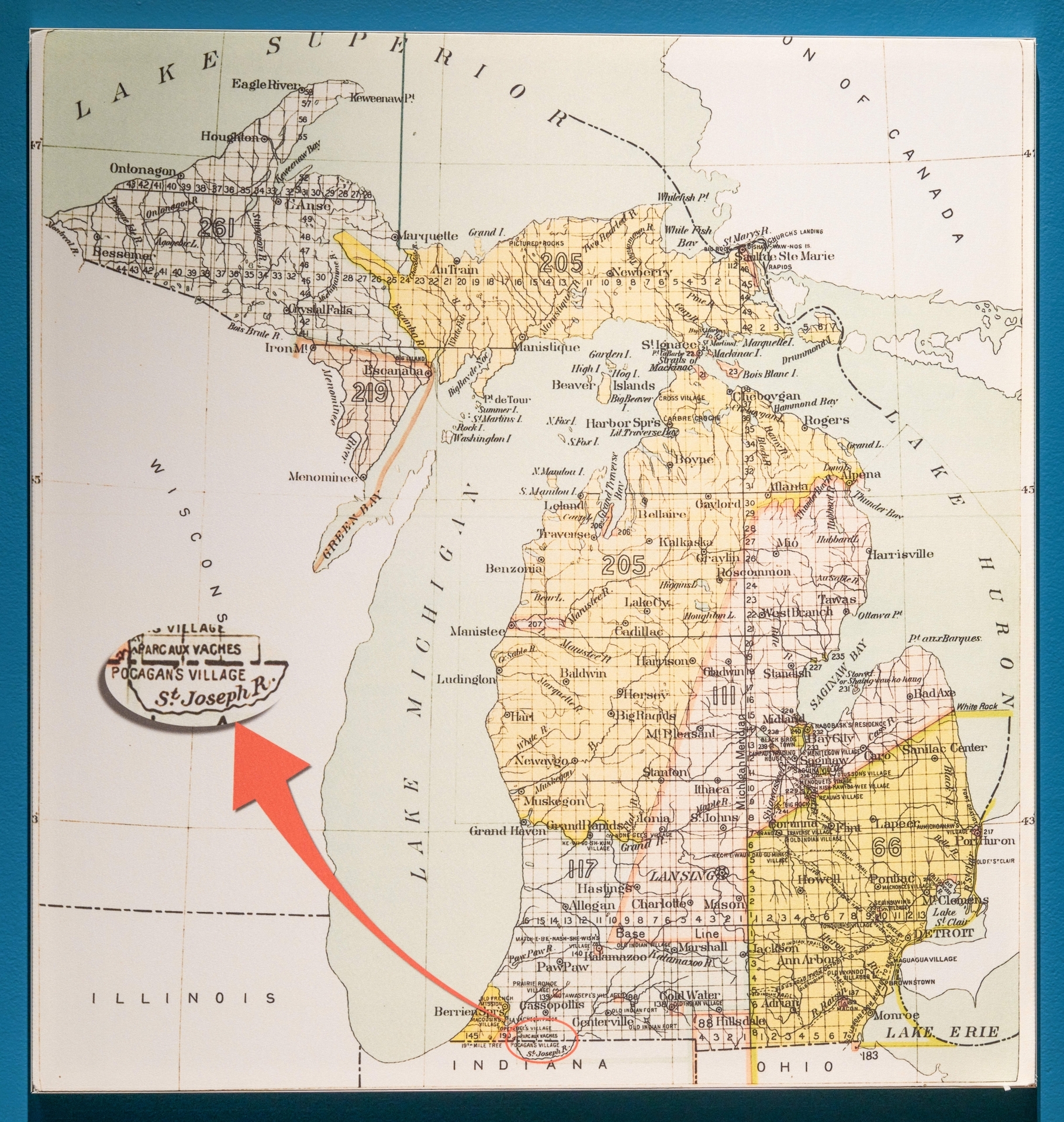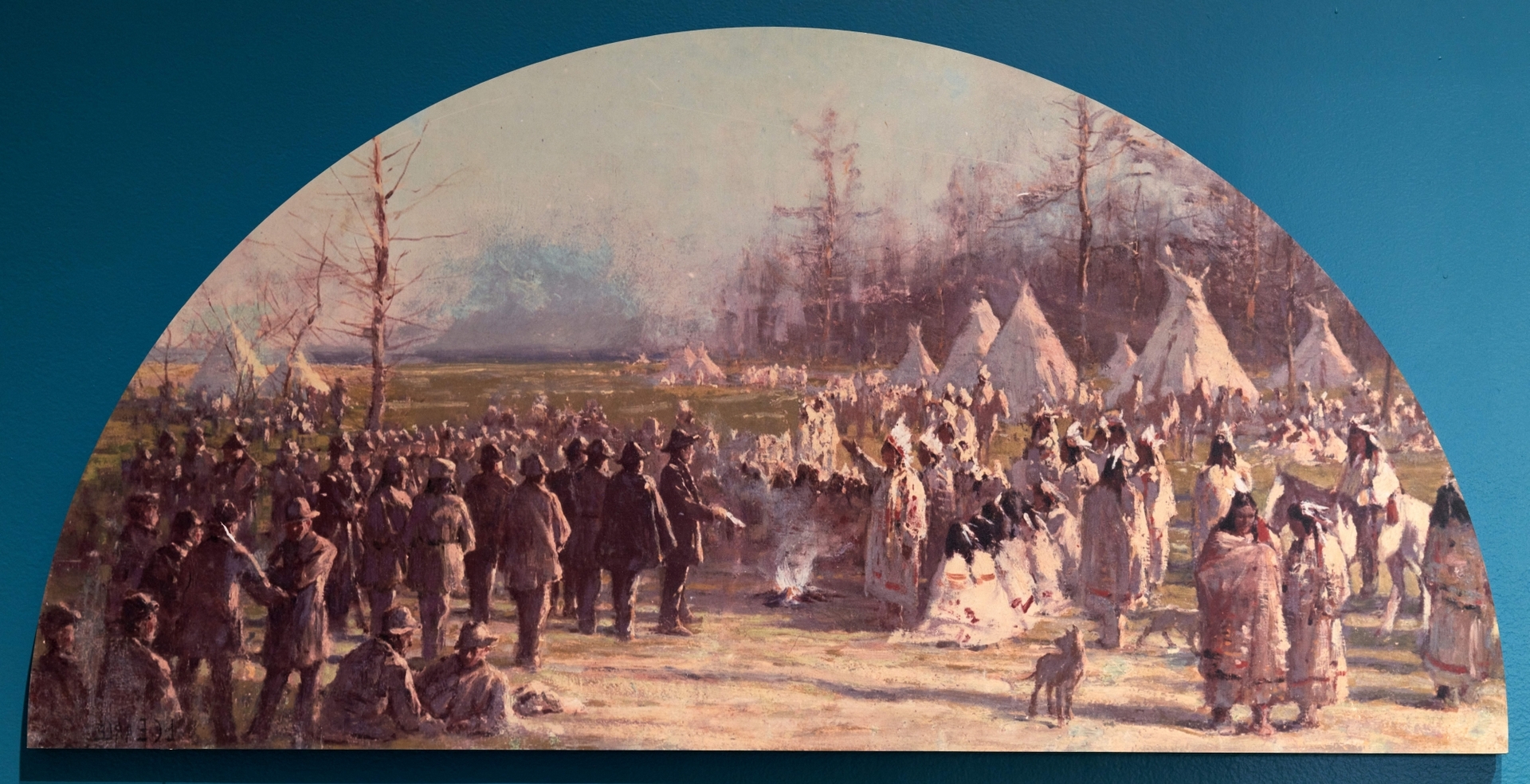




“It is our fixed and
determined purpose to live and die on our present seats. It is sealed to us by
the bones of our fathers. They obtained it by their blood. Our bones shall be
beside theirs. It is the heritage of the Almighty. He gave it to us. He it is who
must take it from us.”
—Six
Nations to the President of the United States, 1818
Land Crisis: Erie Canal
Plans for the Erie Canal cut
right through the heart of Haudenosaunee lands. Where the Haudenosaunee saw a
living landscape that sustained their survival, New York politicians and
businessmen saw opportunities for development and the easiest route to the
West. An early canal proposal characterized the territory as “waste and
unappropriated lands” ripe for the state’s taking.
New York State Surveyor General
Simeon DeWitt used these surveying tools to plot the canal. Planners knew they
were boring through Native land. This map shows the canal winding through places
named after Haudenosaunee communities, including Onondaga Lake, Oneida Creek,
and the Seneca River.
In 1817, the Ogden Land
Company began construction. Supporters championed the canal as a sign of
American progress that would facilitate travel and commerce. Haudenosaunee
communities viewed it as a threat to their lands and ways of life. They
petitioned against private and public attempts to remove them from their homes
along the canal’s route.

Elias Valentine
Map and
profile of the proposed canal from Lake Erie to Hudson River in the State of
New York,
1817
Patricia D. Klingenstein Library, New-York
Historical Society
Surveyor’s kit owned by Simeon DeWitt
Albany Institute of History and Art, bequest of
Sarah Walsh DeWitt, 1924.1.21
Spiritual Crisis: Erie Canal
The land crisis sparked by
the Erie Canal precipitated a spiritual crisis for many Haudenosaunee people.
Which beliefs and practices would protect them? How could they sustain their
culture if they lost the places that anchored and shaped it?
To safeguard the
future of the Longhouse, people turned to several different sources of
spiritual power.
Traditional Practices
Red Jacket (1758–1830)
The Seneca leader Sagoyewatha
or Red Jacket defended traditional Haudenosaunee practices. He distrusted
Christian missionaries, regarding them as accomplices of the whites who were
stealing their lands.
His words to one New England
missionary were published in the broadside shown here. “You have got our
country but are not satisfied; you want to force your religion upon us. You say
there is but one way to worship and serve the Great Spirit. If there is but one
religion, why do you white people differ so much about it? Why not all agreed,
as you can all read the book?”
In 1819, the Ogden Land
Company met with Red Jacket and other Seneca leaders to pressure them into
selling land. Red Jacket spoke for the group when he refused, insisting that
all white men, including the preacher and schoolmaster, leave their
reservations.
Christianity
Reverend Eleazer Williams (1788–1858)
Protestant missionaries had
long worked among the Haudenosaunee. When the Erie Canal broke ground in the
center of the Oneida homeland, many Oneida Christians rallied around Eleazer
Williams, an Episcopalian missionary of Mohawk descent. Williams envisioned an
“Indian empire” in the West. He advised
his Oneida followers to migrate west in order to protect themselves from the
white population and practice Christianity how they saw fit. Between 1820 and
1838, about half of the Oneidas relocated to a new reservation near present-day
Green Bay, Wisconsin.
Williams preached captivating
sermons and enjoyed singing hymns—a mode of worship that resonated with
Indigenous traditions. He also contributed to this prayer book, which was
written in a “reformed Mohawk orthography” for speakers of Mohawk and Oneida.
Its contents include prayers, services, and thanksgivings drawn from the Book
of Common Prayer.
Protestant missionizing among
the Haudenosaunee continued even after most Oneidas moved west. These communion
vessels were used in a Presbyterian mission near the Allegany Seneca Nation
reservation.
Longhouse Philosophy
Handsome Lake (1735–1815)
In the summer of 1818,
spiritual revival swept through the Haudenosaunee council assembled at the
Tonawanda Seneca reservation. Years before, the Seneca prophet Handsome Lake
stood inside this same longhouse and preached a message of moral and social reform.
He revealed his visions in which the Creator sent instructions for revitalizing
Ongwehonweka:a, “the way of life of the original human beings.”
At the 1818 council,
followers of the late prophet revived Handsome Lake’s teachings to unite their
community. The book by a visiting Protestant minister displayed here documents
an oration from council participant John Sky, who “recapitulated the moral
truths delivered by the prophet.”
Handsome Lake’s Longhouse
philosophy of living sought to help adherents move forward despite poverty,
cultural disruption, and land loss. Some of his instructions overlapped with
the counsel of Christian missionaries, but he distinguished his Gaiwi:yo (“Good
Word”) from the Christian Gospel. His message emphasized longstanding beliefs
about the sanctity of family and the value of positive relationships,
generosity, and hospitality. It also sanctioned forms of worship important to
Haudenosaunee identity, including the Midwinter Ceremony, the Strawberry
Festival, and traditional thanksgiving dances.
Bridging Traditions
Caroline Gahano Parker Mt. Pleasant (ca. 1826–1892)
Caroline Parker was an artist
whose life bridged multiple spiritual traditions. Born Tonawanda Seneca and
married into the Tuscarora community, Parker followed prophet Handsome Lake’s
Longhouse philosophy and also was a member of the Tuscarora Baptist Church. She
balanced creative adaptations of Euro-American customs with the preservation of
her Haudenosaunee heritage.
Both influences are present
in Parker’s clothing designs. The outfit she wears in the photo—featuring this
skirt—takes the style of ceremonial Longhouse dress, even as additions like the
white lace collar reference contemporary Victorian fashions. The skirt’s “celestial
tree” motif is a quintessential Haudenosaunee pattern. Bold colors and symbolic
beadwork evoke the feminine powers of Sky Woman, a major figure in the
Haudenosaunee creation story. When worn during ceremonial dances, Parker’s
skirt became a “visual prayer” in motion.*
Caroline Parker’s textile art
illustrates how affiliating with Christianity did not necessarily mean losing
traditional spirituality or culture. Haudenosaunee peoples could adopt diverse
beliefs, philosophies, or perspectives and still remain united as inhabitants
of one Longhouse.
*Description from textile historian Deborah Holler
Threat to Potawatomi Homelands
The Erie Canal gave
Easterners a quick, easy route to the West. Aspiring settlers followed the
canal straight into the Great Lakes homelands of the Potawatomi and other
Native nations. This onslaught of white newcomers in the 1820s disrupted food
supplies and cultural practices, sparked violent encounters, and introduced
fatal diseases. Leaders such as Leopold Pokagon or Sakekwinik struggled to
contain the damage.
Then, in 1830, President
Andrew Jackson signed the Indian Removal Act. This new law sanctioned ongoing
efforts to push Native peoples west of the Mississippi. Pokagon learned that
even the Baptist missionary living in his community supported Jackson’s removal
program. In response, Pokagon cut ties with white Protestants in search of a
more favorable religious and political alliance.
Catholic Allies
Leopold Pokagon’s band of
Potawatomi lived in the St. Joseph River Valley—marked “Pocagan’s Village” at
the bottom of this map. In 1830, Pokagon left home to journey to Detroit. His
mission? To request a "black robe" (Catholic priest) for his
community. Pokagon needed allies and hoped Catholic leaders within the new
Diocese of Cincinnati would help him oppose removal.
Pokagon’s quest was
successful. Impressed with his sincerity and eager to regain influence among a
people once welcoming to French Jesuits, diocesan leaders agreed to send Father
Stephen Badin to establish a mission at Pokagon’s village.
Badin earned Pokagon’s trust.
Many Pokagon Potawatomi—including Pokagon and his wife Elizabeth Topinabee
(Ketesse)—embraced the Catholic faith. Prayer books like this one allowed the
community to read prayers, psalms, and devotions in their own language.

Indian land cessions in the United States, Michigan
Library of Congress, Geography and Map Division
A Religious Exemption
In 1833, Leopold Pokagon
joined 6,000 other Potawatomi in Chicago to negotiate the Treaty of Chicago. US
officials wanted the Potawatomi to cede their lands and move west of the
Mississippi. Pokagon helped negotiate an amendment to the treaty. The amendment
permitted his band to remain in Michigan “on account of their religious creed.”
This map depicts Chicago in
the year of the treaty. It visualizes Native people pushed to the margins, a
future envisioned by the Indian Removal Act. Pokagon won an exemption from
removal by claiming a shared Christianity with the colonizers. But within a
handful of years, other Potawatomi were driven from their homelands. An 1838
forced march to Kansas is known as the “Trail of Death.”
Despite the confident
projections portrayed in this map, resistance from leaders like Pokagon slowed
the speed of “Indian Removal.” Pokagon's decision to ally with Catholic
missionaries who supported his goals was just one example.

Lawrence C. Earle
The Last
Council of the Pottawatomies, 1833, 1900
Chicago History Museum, ICHi-062506
Staying in Place
Pokagon suspected that
Christianity alone would not protect his people from removal. In 1836, he
bought 874 acres of land north of his original village, in what is now Silver
Creek Township, and moved there with his band. In 1840, federal troops
attempted to remove all remaining Potawatomi from the state, disregarding the
Pokagon Band’s exemption. This time, Pokagon received support from Michigan
Supreme Court justice Epaphroditus Ransom, who confirmed the band’s right to
stay largely because Pokagon’s land purchase was legally protected as private
property.
One legacy of the Pokagon
Band’s ability to stay in place is the ongoing tradition of black ash
basketmaking. Black ash trees are native to the swampy areas of the Great Lakes.
Properly harvesting the wood requires specific environmental knowledge. These
trees do not grow in the western climate where the US government sent many
Potawatomi. Pokagon Band members have helped their western relatives maintain
this important part of their culture.